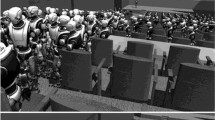Abstract
This paper outlines pedestrians' movement at a signalized intersection of Tehran, Iran's capital. The presented model considers the effects of specific behavior variables derived from Iranian culture and local laws. The social force model has been built and calibrated by considering the crosswalk's geometric and heterogeneous (based on gender) conditions by implementing a genetic algorithm. A fundamental diagram has been used to validate the calibrated model and increase the model's accuracy in estimating pedestrians' density. In this end, the Voronoi algorithm has been used as the most up-to-date method to increase the accuracy in calculating the density. The result shows the normalized root mean square error in density is 0.18, indicating the model's high accuracy. Finally, the comparison of the fundamental diagram resulting from the simulated social force model and reality shows the proper performance of the social force model by a correlation coefficient of 0.74.







Similar content being viewed by others
References
Afandizadeh Sh, Khaksar H, Kalantari N (2013) Bus fleet optimization using genetic algorithm a case study of Mashhad. Int J Civ Eng 11(1):43–52
Bandini S, Mondini M, Vizzari G (2014) Modelling negative interactions among pedestrians in high density situations. Transp Res Part C Emerg Technol 40:251–270. https://doi.org/10.1016/j.trc.2013.12.007
Camazine S, Jean-Louis D, Nigel RF, James S, Eric B, Guy T (2003) Self-organization in biological systems. Princeton University Press, Princeton
Cao S, Song W, Lv W (2016) Modeling pedestrian evacuation with guiders based on a multi-grid model. Phys Lett A 380(4):540–547. https://doi.org/10.1016/j.physleta.2015.11.028
Chen S, Libi Fu, Fang J, Yang P (2019) The effect of obstacle layouts on pedestrian flow in corridors: an experimental study. Physica A 534:122333. https://doi.org/10.1016/j.physa.2019.122333
Daamen W, Hoogendoorn SP (2007) Free speed distributions—based on empirical data in different traffic conditions. In: Pedestrian and evacuation dynamics 2005. Springer, Berlin, Heidelberg, Chicago, pp 13–25
Fata AZ, Azizul SK, Rahim MSM, Saba T, Rehman A (2016) Zahmah social force model for pedestrian movement. J Theor Appl Inf Technol 92(1):181
Fruin JJ (1970) Designing for pedestrians a level of service concept. Polytechnic University
Fu Z, Li T, Deng Q, Schadschneider A, Luo L, Ma J (2021) Effect of turning curvature on the single-file dynamics of pedestrian flow: an experimental study. Physica A 563:125405. https://doi.org/10.1016/j.physa.2020.125405
Gao J, Zhang J, He J, Gong J, Zhao J (2020) Experiment and simulation of pedestrian’s behaviors during evacuation in an office. Physica A 545:123749. https://doi.org/10.1016/j.physa.2019.123749
Helbing D (1991) A mathematical model for the behavior of pedestrians. Behav Sci 36(4):298–310
Helbing D, Molnar P (1995) Social force model for pedestrian dynamics. Phys Rev E 51(5):4282
Henderson LF (1971) The statistics of crowd fluids. Nature 229(5284):381–383
Huang Z, Chraibi M, Cao S, Huang C, Fang Z, Song W (2019) A microscopic method for the evaluating of continuous pedestrian dynamic models. Physica A 536:122461. https://doi.org/10.1016/j.physa.2019.122461
Jiang Y-Q, Bo-Kui C, Bing-Hong W, Weng-Fai W, Bing-Yang C (2017) Extended social force model with a dynamic navigation field for bidirectional pedestrian flow. Front Phys 12(5):124502
Johansson A (2009) Data-driven modeling of pedestrian crowds. Doctoral Thesis. Technische Universität Dresden
Johansson A, Helbing D, Shukla PK (2007) Specification of the social force pedestrian model by evolutionary adjustment to video tracking data. Adv Complex Syst 10(supp02):271–288
Lee J, Kim T, Chung J-H, Kim J (2016) Modeling lane formation in pedestrian counter flow and its effect on capacity. KSCE J Civ Eng 20(3):1099–1108
Li X, Telesca L, Lovallo M, Xuan Xu, Zhang J, Song W (2020) Spectral and informational analysis of pedestrian contact force in simulated overcrowding conditions. Physica A 555:124614. https://doi.org/10.1016/j.physa.2020.124614
Liang M, Jie Xu, Jia L, Qin Y (2020) An improved model of passenger merging in a Y-shaped passage. Physica A 540:123233. https://doi.org/10.1016/j.physa.2019.123233
Liu H, Liu B, Zhang H, Li L, Qin X, Zhang G (2018) Crowd evacuation simulation approach based on navigation knowledge and two-layer control mechanism. Inf Sci 436–437:247–267. https://doi.org/10.1016/j.ins.2018.01.023
Liu M, Weiliang Z, Peng C, Xuyi W (2017) A microscopic simulation model for pedestrian-pedestrian and pedestrian-vehicle interactions at crosswalks. PLoS ONE 12(7):e0180992
Mintz A (1951) Non-adaptive group behavior. Psychol Sci Public Interest 46(2):150
Siddharth SMP, Vedagiri P (2018) Modeling the gender effects of pedestrians and calibration of the modified social force model. Transp Res Rec 2672(31):1–9
Steffen B, Seyfried A (2010) Methods for measuring pedestrian density, flow, speed and direction with minimal scatter. Physica A 389(9):1902–1910
Teknomo K (2016) Microscopic pedestrian flow characteristics: development of an image processing data collection and simulation model. arXiv preprint arXiv:1610.00029
Yuan Z, Jia H, Liao M, Zhang L, Feng Y, Tian G (2017) Simulation model of self-organizing pedestrian movement considering following behavior. Front Inform Technol Electron Eng 18(8):1142–1150
Zeng W, Chen P, Nakamura H, Iryo-Asano M (2014) Application of social force model to pedestrian behavior analysis at signalized crosswalk. Transp Res Part C Emerg Technol 40:143–159
Zeng W, Chen P, Guizhen Yu, Wang Y (2017) Specification and calibration of a microscopic model for pedestrian dynamic simulation at signalized intersections: a hybrid approach. Transp Res Part C Emerg Technol 80:37–70. https://doi.org/10.1016/j.trc.2017.04.009
Zhang B, Chen W, Ma X, Qiu P, Liu F (2020) Experimental study on pedestrian behavior in a mixed crowd of individuals and groups. Physica A 556:124814. https://doi.org/10.1016/j.physa.2020.124814
Zhou Z, Zhou Y, Ziyuan Pu, Yongneng Xu (2019) Simulation of pedestrian behavior during the flashing green signal using a modified social force model. Transp A Transp Sci 15(2):1019–1040
Zhu Yu, Chen T, Ding N, Chraibi M, Fan W-C (2020) Follow the evacuation signs or surrounding people during building evacuation, an experimental study. Physica A 560:125156. https://doi.org/10.1016/j.physa.2020.125156
Zou B, Chunxia Lu, Mao S, Li Yi (2020) Effect of pedestrian judgement on evacuation efficiency considering hesitation. Physica A 547:122943. https://doi.org/10.1016/j.physa.2019.122943
Author information
Authors and Affiliations
Corresponding authors
Rights and permissions
About this article
Cite this article
Afandizadeh, S., Esmailzadeh Kivi, S. & Mirzahossein, H. Pedestrian Self-organization Modeling with Behavioral Variables at a Signalized Intersection. Iran J Sci Technol Trans Civ Eng 46, 4705–4718 (2022). https://doi.org/10.1007/s40996-022-00863-4
Received:
Accepted:
Published:
Issue Date:
DOI: https://doi.org/10.1007/s40996-022-00863-4




